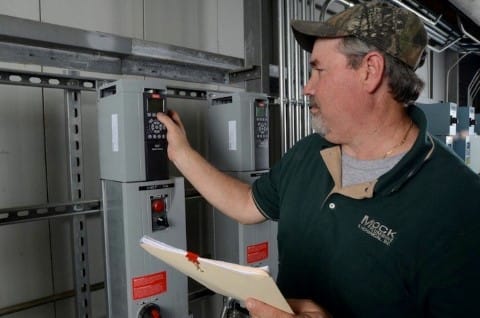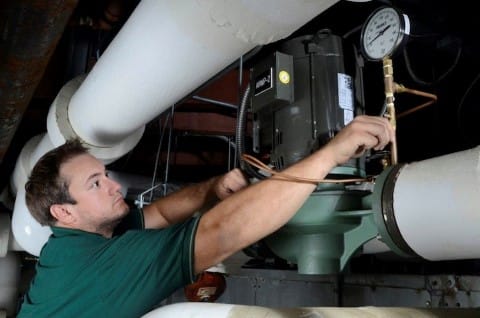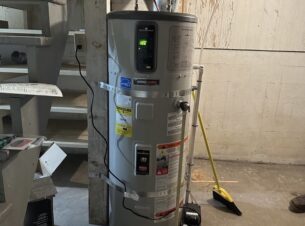Fixing an old problem typically brings a measure of satisfaction. Fixing one that’s not “old,” and has expensively festered from the beginning while also making a nuisance of itself adds new facets to the challenge.
Ultimately, the solution to a university’s vexing HVAC problem has won accolades from school administrators, students, faculty, and maintenance staff alike.
Inside Armstrong Atlantic State University’s (AASU) two-story, 126,000-square-foot Science Center in Savannah, GA, is a network of 36 laboratories, classrooms and offices. After construction wrapped-up in 2001, the building’s VAV (variable air volume) exhaust and HVAC equipment showed its true colors. The ambient noise level in the laboratories was 72 dBa and the system was anything but VAV.
 Robert Stephens, lead HVAC technician at Mock Plumbing and Mechanical, sets up the parameters of the a variable frequency drive connected to an exhaust fan at the Science Center.
Robert Stephens, lead HVAC technician at Mock Plumbing and Mechanical, sets up the parameters of the a variable frequency drive connected to an exhaust fan at the Science Center.
Codes and standards intended to protect an individual’s health and safety inside science and research laboratories require frequent air changes and constant negative pressure. These standards apply 24 hours a day including holidays, nights and weekends. The Science Center’s 78 fume hoods ran constantly, moving 800 CFM each — whether the laboratory fume hoods were in use or not.
A functional and controlled exhaust system can modulate to a lower volume when the room is unoccupied, while still providing safety. But the system at the Science Center ran full-tilt ‘round the clock. The building quickly became the school’s loudest and most expensive energy burden.
 Shawn Norman, of Mock Plumbing and Mechanical, inspects the wiring on a pump used for the Science Center’s run-around loop.
Shawn Norman, of Mock Plumbing and Mechanical, inspects the wiring on a pump used for the Science Center’s run-around loop.
“Holding classes with high ambient noise levels became a very big problem,” said David Faircloth, director of plant operation at the 6,000-student university. “And we quickly felt the fiscal strain of maintaining 10 ACH (air changes per hour) in the building at all times. In terms of installed equipment, the building represents 25 percent of the campus’ entire capacity. But in terms of energy consumption, it accounted for 40 percent of use.”
Operating costs aside, school managers struggled for five years in their attempts to quiet the complaints about classroom noise. That is, until an experimental retrofit was born.
Meeting of the minds
With repair and renovation funds from the Board of Regents Facilities Office, the university embarked on a test project to see if retrofitting the entire building was financially feasible. A single-laboratory pilot project began in 2006.
Faircloth assembled the ideal team. Chuck Hanning, P.E., was chosen to design the system. Hanning is senior mechanical engineer at Rosser International, an Atlanta-based architecture and engineering firm.
Atlanta-based Thermal Recovery Systems (TRS) contributed to the design and supplied many of the system components. TRS is a commercial and industrial manufacturer’s rep firm that has served Georgia for over 30 years. Mock Plumbing and Mechanical was the contractor of choice, based on their prior work for the University.
The test project would be General Chemistry Lab 2102. Originally, the 1,450 square-foot room was equipped with a dozen constant-volume fume hoods, cantankerous controls, and a terminal unit that was capable of supplying only one-third of the needed make-up air.
There were three key objectives for the pilot project: reduce noise level, correct the non-functional VAV operation of the exhaust system, and reduce energy consumption.
Loud and inefficient
“While searching for the root of the problem, we learned – among other things – that the fume hoods would not modulate, the hoods lacked blank-off plates, and the fan bypass dampers were never powered.” said Tim Crawford, of TRS.
To comply with laboratory codes, the system needed to run 24 hours a day, seven days a week. But at the Science Center, the faulty system couldn’t be turned down when the room was vacant. The Science Center’s exhaust system evacuated more than enough air to fill the Empire State Building twice a day. Yes: 74,000,000 cubic feet.
“Each lab room requires eight ACH when occupied, and half that when vacant.” said Hanning. “But these laboratories were getting 10 ACH ‘round the clock.”
Combined, the fume hoods in Lab 2102 pulled 9600 CFM out of the room, while the air handling unit could only supply 3,000 CFM of conditioned air. The rest of the make-up air was drawn through transfer ducts connecting the room with the adjacent corridor.
Prototype
Instead of using one constant-volume fan at each fume hood, the new design called for a common fan system. On the roof, a 10-horsepower Danfoss VFD (variable frequency drive) was used to control a Hartzell exhaust fan, and ductwork was installed on the roof to consolidate exhaust from all of the fume hoods.
Replacing numerous fans with one central fan immediately lowered the room’s sound level. To further cut back on noise, a Kinetics Noise Control sound attenuator was used on the exhaust fan, and sound baffles were placed on the ceiling of the lab.

Thermal sensors on the fume hoods were replaced with cable sash sensors and digital fume hood monitors equipped with emergency purge buttons. Zone presence sensors were installed, so each fume hood can be individually and automatically set back.
With the exhaust volume properly in check, focus turned to supply air. Mock’s technicians replaced the airflow devices and controls with Phoenix Controls 12-inch high-speed venturi valves, which further helped with noise reduction. This offered the exact make-up air needed; no more, no less.
“When the VAV fume hood pilot project was completed, the noise complaints dropped off,” said Faircloth. “We can use the project as an applied example of energy conservation in class. Even with one lab renovation, we could see the savings. The pilot project gave us a template for the rest of the building.” One by one, the lab rooms transformed.
Investing in educationWith the success of the pilot project, AASU sought ARRA (American Recovery and Reinvestment Act) funding to retrofit the rest of the building. Funds totaling 1.5 million dollars were granted, and the project began immediately. The sweeping renovation would show a 36% reduction in energy consumption for the Science Center.
Instead of 78 constant volume fans on the roof, there are now 12, with VFDs controlling the fan motors. Six fans maintain a VAV duct system at 1.6 inches negative pressure, while the other six provide backup.
Through the use of VFDs, the fans are accurately ramped up and down to maintain the static pressure set-point. In a laboratory, a slight deviation from the set-point could result in hazardous conditions and code violations – defining the importance of total fan redundancy.
Sound of silenceIn the event of a pop quiz, students who attend class in the Science Center will need to find a new alibi for not absorbing information. Excessive fume hood noise drowning out the instructor is no longer a viable excuse. Gone is the end-of-semester curve for HVAC system interruption.
To help reduce noise from the rooftop fans, Mock employees installed the packless-type sound attenuators at the inlet to each fan. Stainless steel construction offers annual wash-down ability by the AASU maintenance staff so that any collected chemicals can be eliminated on a regular basis.
“After the installation of the venturi valve system and sound attenuators, the ambient noise in the rooms measured 62 dBa,” said Crawford. “With the addition of the sound baffles, that number dropped to 51 dBa with all the fume hoods operating at full capacity.”
Suspended from the ceiling in each lab room noise control baffles further diminish the already-improved sound level. “The noise problem was the starting point for the entire project,” said Faircloth. Our educators and students can now speak using a normal voice.” A total noise reduction of 21 dBa made the sound reduction goal of the project a home run.
Giving energy loss the run around
Another interesting facet of the systems design is the reworking of the existing hydronic heating system to form a run-around loop between the air handler preheat coil and the air terminal reheat coils.
“Air handlers 1 and 2 serve the second floor and air handler 4 serves the first floor,” said Hanning. “In the summer, the run-around loop transfers heat from the outside air to the preheat coil, and a Taco inline pump circulates warm water to the reheat coils.” Additional savings are achieved by reducing the outside air temperature entering the cooling coils.
The run-around loop is connected to the hydronic system through a control valve. The control system monitors space conditions and opens the control valve to increase the loop water temperature as needed.
“All we’re doing is reclaiming some energy from unused parts,” explained Hanning.
Win-win situationThe M&V report conducted in early 2012 showed an energy savings of $192,000 per year, at current electric and natural gas rates. However, that number isn’t indicative of all the savings the project is capable of.
Because the data period didn’t include weather conditions over a hot, humid Savannah summer, it’s estimated that an additional $45,000 savings is likely. That would bring the total to $237,000, or a 36% reduction in energy cost for the building; 11% reduction campus-wide.
“In 2001, the emphasis was on laboratory safety, not energy efficiency,” said Faircloth. “I think it’s safe to say that both are of the utmost importance now.”




Join the conversation: